Meta-analysis of the acupoint application therapy for stable chronic obstructive pulmonary disease
YIN Ya-qin, ZENG Jun-rui, SHEN Feng
College of Acupuncture and Orthopedics Affiliated to Hubei University of Chinese Medicine, Wuhan 430061, China
Keywords:
ABSTRACT
1.Introduction
Chronic obstructive pulmonary disease(COPD)is one of the most common chronic respiratory diseases.It is typically characterized by persistent respiratory symptoms and incomplete reversible airflow limitation.With the environmental change, COVID-19 pandemic and the advent of an aging society, the prevalence of this disease will continue to increase in the next 40 years.By 2060, more than 5.4 million people may die of COPD and its related complications and diseases every year[1], so the prevention and treatment of COPD has far-reaching social significance.
At present, the defects of high cost of western medicine treatment, drug resistance and adverse reactions lead to poor patient compliance.Acupoint application is a characteristic external treatment method of traditional Chinese medicine, which combines seasonal solar terms, compatibility of traditional Chinese medicine and meridian theory.Because of its cheap, effective, safe and other advantages, it is widely used in lung diseases.In recent years, there have been more and more clinical studies on acupoint application in the treatment of COPD,but the stability of the efficacy has not been affirmed due to biased factors such as non-standard trial design and small number of samples.Therefore, this study uses the method of Meta analysis to systematically evaluate the relevant literature in the past ten years, in order to scientifically verify the safety and effectiveness of acupoint application therapy, and provide a certain reference basis for clinical treatment.
2.Materials and methods
2.1 Retrieval strategy
Computer search: Chinese databases include China National Knowledge Infrastructure (CNKI), Chinese Biomedical Literature Database(CBM), Wanfang Database(WF), China Science and Technology Journal Database (VIP).Foreign language databases include Pubmed, Cochrane Library and Embase.And manually supplementary search of core journals, Chinese and foreign clinical trial registration centers and so on, in order to comprehensively search the relevant randomized controlled trial literature.Chinese search words: The name of the disease are “chronic obstructive pulmonary disease”,“stable phase of chronic obstructive pulmonary disease”,“chronic obstructive pulmonary disease”, “COPD”and so on.The intervention measures are “acupoint application”,“acupoint application”,“summer treatment of winter disease”,“Sanfu patch”,“Sanjiu patch” and so on.The research types are“randomized controlled trial”, “randomized controlled trial”,“randomized controlled trial”and“RCT”.English search words: The names of diseases include“Pulmonary Disease, Chronic Obstructive”,“Chronic Obstructive Lung Disease”,“Chronic Obstructive Pulmonary Diseases”,“COPD”,“COAD”and so on.Interventions include“Dogdays Acupoint Application”,“Blistering Therapy”,“Acupoint Sticking Therapy”and so on.The types of research include“Randomized Controlled Trial”,“randomized”,“placebo”and so on.The search period is limited to 1 January 2013 to 1 March 2023.
2.2 Inclusion criteria
①Research object: The patients in the study meet the accepted diagnostic criteria for stable COPD and excluded severe primary diseases.②Intervention measures: The treatment group is treated with acupoint application combined with routine western medicine(oxygen therapy, application of bronchodilators,expectorants, inhaled corticosteroids, etc).The control group is treated with or without placebo application combined with routine treatment.③Research type: Randomized controlled trial (RCT),unrestricted blind method.④Outcome index: The main outcome indicators are total effective rate (TE), one-second rate (FEV1/FVC ratio), St.George’s respiratory disease questionnaire score(SGRQ score).And the secondary outcome indicators are Body mass index,airflow obstruction,dyspnea,and exercise capacity index (BODE index),COPD assessment test (CAT score) and TCM syndrome score.
2.3 Exclusion criteria
①The patients in the literature who participate in the trial are in the acute episode of COPD.②Repeat publication or series of articles.And the types of literature are review,systematic review,experience summary, medical records or animal experiments.③In addition to acupoint application, other therapeutic measures such as oral administration of traditional Chinese medicine are used in the intervention.④There are obvious errors in the research data in the literature, or complete data cannot be obtained.⑤The outcome index used in the literature is not consistent.
2.4 Literature screening and data extraction
Two researchers read and screen independently according to the inclusion and exclusion criteria.If there is a dispute between the two researchers on whether some literature is included in the screening process, the third party will negotiate and resolve it, and finally determine the literature to be included in the study.In order to ensure the accuracy of the extracted information, the two researchers independently set up Excel tables to standardize all the data, and then carried out the next step of statistical analysis after unifying their opinions and cross-checking.The extracted information includes the basic data of the literature, the methodological characteristics of the trial, specific control and intervention measures, details of the implementation process, outcome index data and so on.
2.5 Quality evaluation of included literature
In this study, the bias risk assessment tool provided by Cochrane collaboration Network is used to evaluate the quality of the included literature.It mainly includes the following aspects:①Whether the generation of random sequence is correct.②Concealment of random allocation scheme.③Blind method.④The integrity of the outcome data.⑤Selective report.⑥Other biases.Each aspect makes the evaluation of “high”, “unclear” and “low” respectively.
2.6 Statistical analysis methods
Review Manager 5.3 software is used to analyze the data of the outcome index.The counting data of randomized controlled trials use relative risk (RR value) as the effect quantity, and the measurement data use the weighted mean difference (MD value) as the effect quantity, and calculate 95% confidence interval.Secondly,heterogeneity is judged by chi-square test.If P>0.1 and I250%, the homogeneity of each study is good, so it can be combined with fixed effect model.On the contrary, if P<0.1 and I2>50%, it means that the heterogeneity is large.Sensitivity analysis and subgroup analysis are used to judge the source of heterogeneity, and the random effect model is combined with the effect.If the research results can not be statistically processed, descriptive analysis can be carried out.When the number of articles of an outcome index is more than 10, the publication bias of the included literature is evaluated by drawing a funnel chart.
3.Results
3.1 Literature screening
1 650 Chinese articles and 25 English articles are obtained by preliminary search.Three articles are obtained from the supplementary search in the China Clinical Registration Center,and finally 1 678 articles are obtained.The titles of all the literatures are imported into NoteExpress to check and find 1 007 duplicate literatures.Read the titles of the remaining 671 articles according to the standard and download the full text for strict selection.Finally, 42 articles are included in the study, all of which are Chinese literature.The specific screening process is shown in figure 1.
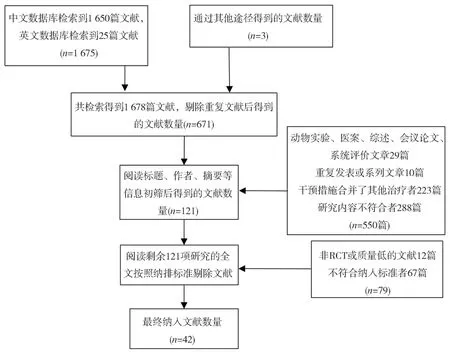
Fig 1 Flowchart of literature screening
3.2 The basic characteristics of entering the literature
A total of 4 192 patients are enrolled in 42 clinical randomized controlled trials, including 2 099 in the treatment group and 2 093 in the control group.40 studies[2-20,23-43] are the comparison of acupoint application combined with western medicine routine treatment and western medicine routine treatment.Two studies[21-22]are compared between acupoint application combined with western medicine routine treatment and placebo application combined with western medicine routine treatment.All the included studies are compared in terms of gender, age and other information, and the baseline data are comparable.

Fig 2 Scale diagram of biased risk assessment results included in the study
In all the intervention measures, the retention time of single acupoint application ranged from 0.5 h to 12 h, and the course of treatment ranged from 10 days to 3 years.And the timing of treatment is mostly Dog-days.10 studies[3,7,11,16-17,22,25,35,37,42] are followed up,9 studies[9,11,16-18,22,28,30,35] reported shedding, and 8 studies[3,16-17,21-22,28,30,35] reported adverse reactions.The basic characteristics of the study are shown in Table 1.
3.3 Bias risk assessment included in the study
All studies are randomized controlled trials and randomized trials are mentioned.Among them, 25 studies[4,6-7,10-13,16-17,19,22-24,26,28,30-32,34-35,38-42] describe the way of randomized grouping.Xiong Wuzhong’s research[8] designed double blindness, while Yu Binyan and Yang Jie’s study[21,28] designed single blindness.Other studies did not describe the blind method.Only Yu Binyan’s research[28] applied envelope hiding scheme, and other studies did not describe allocation concealment.The shedding of 9 studies is discussed by two researchers, which did not affect the analysis of the final conclusion, and no shedding is found in the other studies.The outcome data of all studies are complete, and there is no selective reporting.Other biases are not described and the risks are not clear,as shown in figures 2 and 3.
3.4 Other data extraction
3.4.1 Selection of acupoints for application
The acupoints with a frequency of more than 2 times in 42 studies are as follows:Feishu (41), Shenshu (22), Dingchuan (22), Dazhui(23), Pishu (17), Gizhong (15), Tiantu (15), Geshu (12), Zusanli (7),Xinshu (7), Guanyuan (4), Feng Men (4), Zhongfu (4), Gaohuang(3), Shenque (3), Fenglong (3), Qihai (2).
3.4.2 Selection of traditional Chinese Medicine for Acupoint Application
In 42 studies, the traditional Chinese medicine with the frequency of acupoint application more than 3 times are as follows:White Mustard Seed (38), Herb of Manchurian Wildginger (36), Radix Kansui (27), Corydalis Rhizoma (26), Pinellia Ternata (9),Herba Ephedrae (7), Borneol Flakes (7), Cinnamon (6), Aconiti Lateralis Radix Praeparata (5), Ginger (4), Fructus Perillae (3),Chalcanthitum(3), Camphor (3), Milkvetch Root (3).
3.5 Results of Meta analysis
3.5.1 Efficiency comparison
A total of 27 studies[2,4-6,8-9,12-18,23,25-27,29,31-33, 38-43] compared the effective rates of the two groups after treatment, and a total of 2893 patients are included for Meta analysis.The heterogeneity test shows that the homogeneity is better because the heterogeneity result is P=0.20>0.1 and the I2=18%.The results show that the total effective rate of acupoint application combined with westernmedicine treatment group is better than that of simple western medicine treatment group[RR=1.23, 95%CI(1.19, 1.27), P<0.000 01].See figure 4 below.It can be seen that the dots on both sides of the midline are not completely symmetrical and concentrated in the middle, and there may be a certain publication bias, as shown in figure 5.

Tab 1 Basic characteristics of the included studies
3.5.2 FEV1/FVC comparison
A total of 25 studies[4,7,9,12,14-22,24,26-29,32-34,38-41]compared the FEV1/FVC of the two groups after treatment, and a total of 2303 patients are included for Meta analysis.Heterogeneity test P<0.000 01 and I2=87% suggest that there is high heterogeneity among studies.Subgroup analysis and sensitivity test can not identify the source of heterogeneity, considering the existence of course of treatment, application time and other bias factors, using random effect model.The results show that the improvement effect of acupoint application combined with western medicine on FEV1/FVC ratio is significantly better than that of western medicine alone[MD=4.46, 95%CI(3.17, 5.76), P<0.000 01], as shown in figure 6.By observing the funnel diagram drawn, it can be seen that most of the dots are distributed in the middle and upper part and concentrated toward the midline, but the symmetry is not good.Therefore, the accuracy of the 25 studies included in this group is acceptable, but there is still a certain risk of publication bias, as shown in figure 7.

Fig 3 Summary map of bias risk assessment included in the study
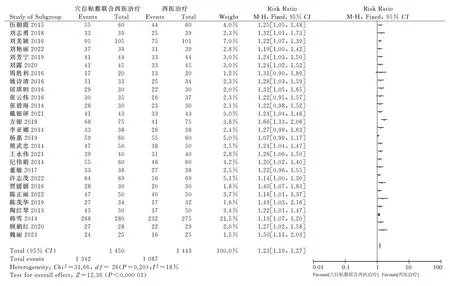
Fig 4 Forest map of comparison of effective rate between acupoint application treatment group and control group
3.5.3 BODE index comparison
A total of 5 studies[7,10,13,16,40] compared the BODE index of the two groups after treatment.A total of 232 patients are included for Meta analysis.Heterogeneity test P<0.00001 and I2=86% suggests that there is a high degree of heterogeneity among studies.After sensitivity analysis, it is found that the heterogeneity decreases significantly after excluding Xu Zhimao 2022.After reading the original text carefully, there was no significant difference in BODE index score between the two groups after treatment, which has a great influence on the final Meta analysis result.Therefore, after excluding this study, we carry out the heterogeneity test again,P=0.15>0.1 and I2=43%<50%, which belongs to mild heterogeneity,indicating that there is a good homogeneity among the remaining four studies, and the fixed effect model can be used to combine effects.The results show that the improvement of BODE index by acupoint application combined with western medicine is better than that of western medicine alone[MD=-0.63, 95%CI(-0.87, -0.40),P<0.000 01],as shown in figure 8.
3.5.4 SGRQ score comparison
In 9 studies[11,18,22,28,33-34,39-40,43], the SGRQ scores of the two groups after treatment were compared.A total of 799 patients are included in the Meta analysis.Heterogeneity test P<0.00001 and I2=90% suggest that there is a high degree of heterogeneity among studies.Subgroup analysis and sensitivity analysis can not identify the source of heterogeneity, there are multiple biased factors, using random effect model to merge.The results show that the reduction of SGRQ score by acupoint application combined with western medicine is significantly better than that of western medicine alone[MD=-6.77, 95%CI(-9.81, -3.72), P<0.000 01],as shown in figure 9.
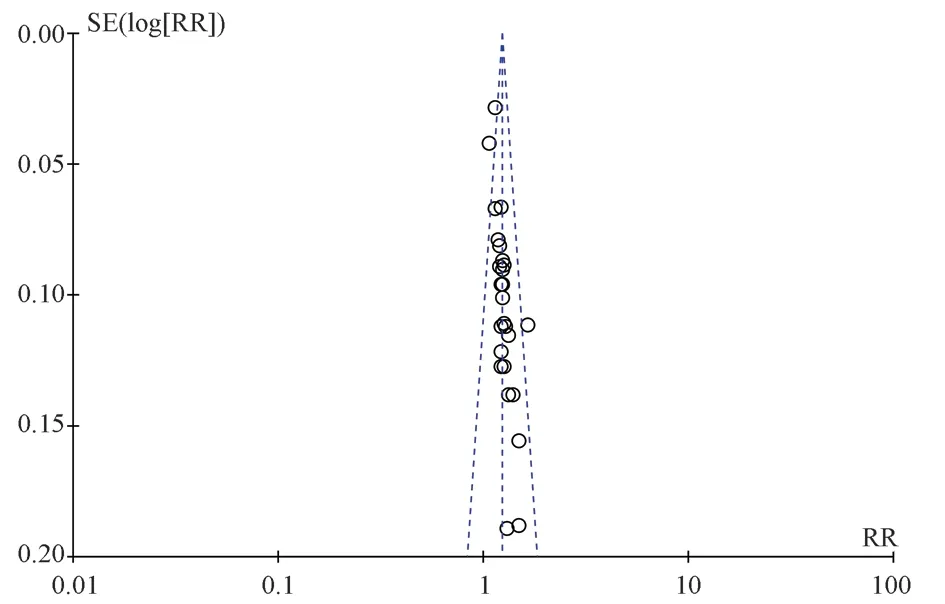
Fig 5 Funnel chart of comparison of effective rate between acupoint application treatment group and control group
3.5.5 CAT score comparison Eight studies[3,7 20,23,30,35-37] compared the CAT scores of the two groups after treatment.After carefully reading the original text, we found that Zhang Jiaquan’s study was inconsistent with the units used in other studies, which has a great impact on the results, so we exclude this study and finally include 529 patients for Meta analysis.The heterogeneity test shows that the homogeneity is better because the heterogeneity is P=0.34>0.1 and I2=12%.The fixed effect model is used to merge.The results show that the effect of acupoint application combined with western medicine in reducing CAT score is better than that of simple western medicine group[MD=-3.33,95%CI(-3.87, -2.79), P<0.000 01],as shown in figure 10.
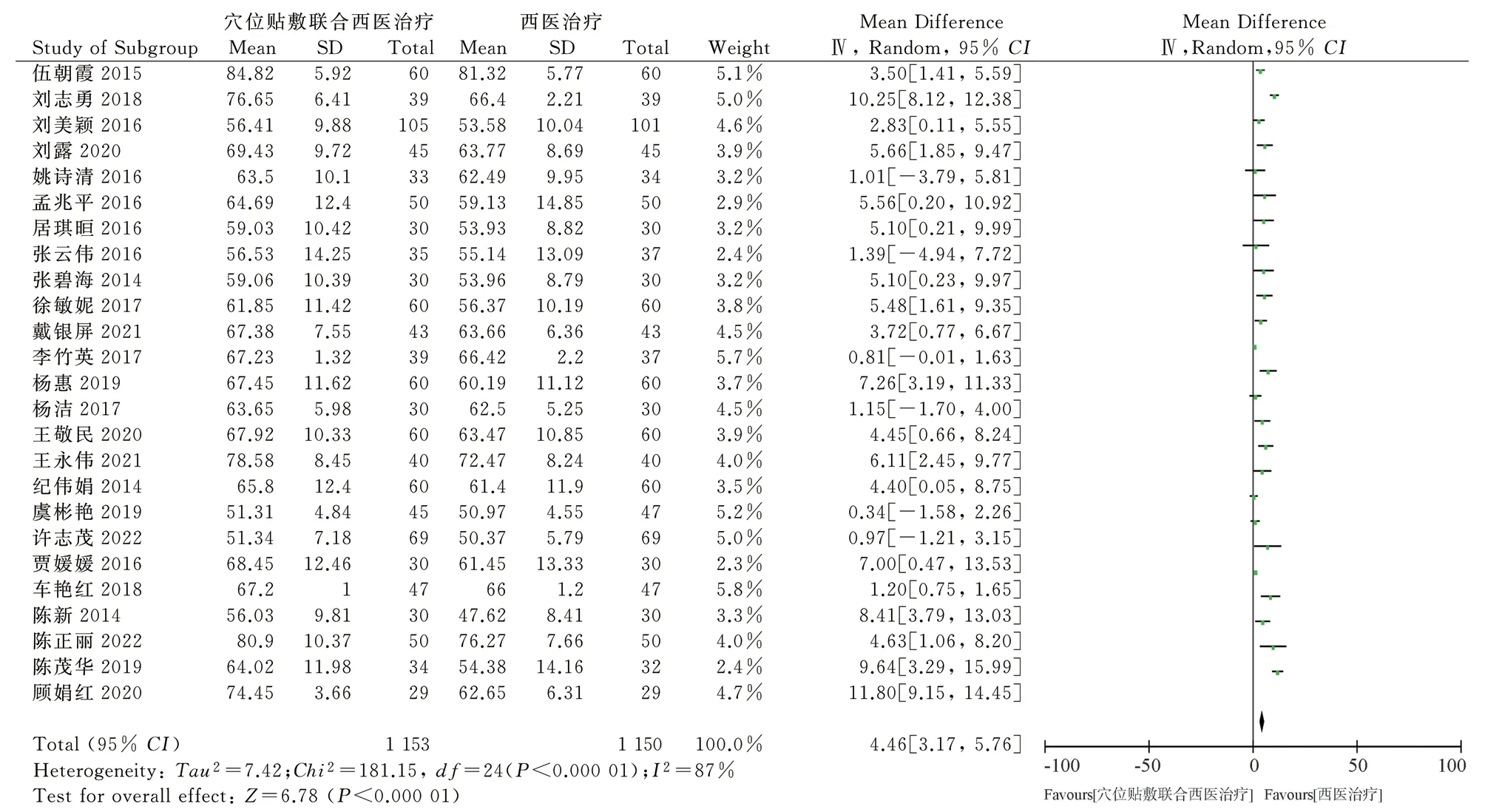
Fig 6 Forest map of FEV1/FVC comparison between acupoint application treatment group and control group
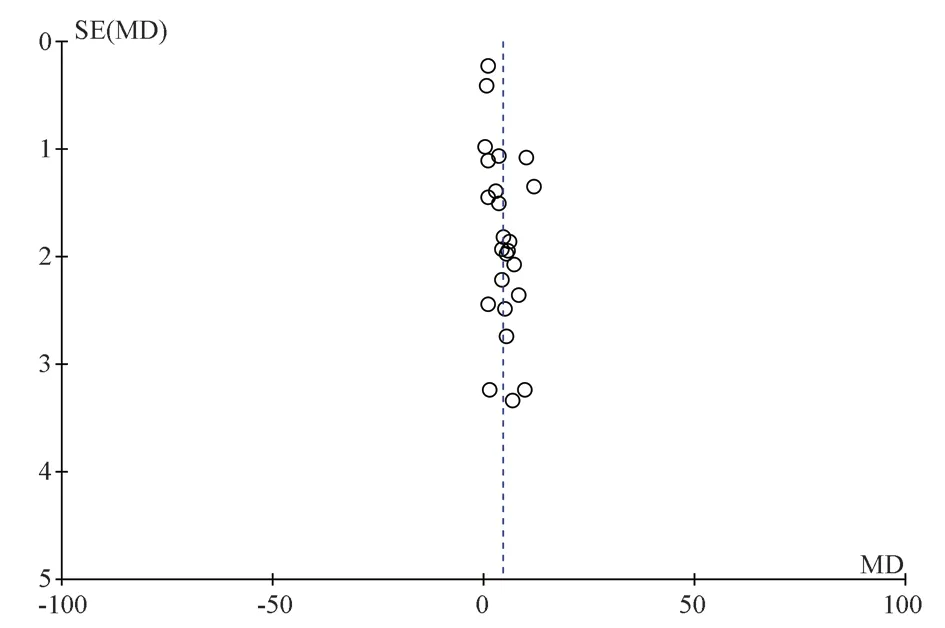
Fig 7 Funnel diagram of FEV1/FVC between acupoint application treatment group and control grou
3.5.6 Comparison of syndrome scores of traditional Chinese medicine
Six studies[7,16,21,35,40,42] compared the TCM syndrome scores of the two groups after treatment, and a total of 480 patients are enrolled for Meta analysis.Heterogeneity test P<0.0001 and I2=81%suggest that there is high heterogeneity among studies.Sensitivity analysis found that Yang Jie 2017’s research has a great influence on the results.Different from other studies, this study uses the syndrome score table of internal medicine of traditional Chinese medicine,which is considered as the source of heterogeneity.Therefore, after excluding this study, the heterogeneity test P=0.31>0.1 and I2=17%shows that the homogeneity of the rest of the study is better, and the fixed effect model is used to combine the heterogeneity test.The results show that acupoint application combined with western medicine treatment can significantly reduce the score of TCM syndrome [MD=-3.51, 95%CI(-3.96, -3.06), P<0.00001],as shown in figure 11.
3.6 Safety evaluation
Among the 42 studies, 7 studies described adverse reactions, 1 study described no adverse reactions, and the remaining 34 studies did not mention them.A total of 42 cases of adverse reactions are reported, accounting for 42/4192 of the total sample size.It includes 1 case of skin damage, 1 case of skin adverse reaction, 2 cases of local allergy, 2 cases of pruritus, 6 cases of skin blistering, 30 cases of skin redness.After treatment, there are no adverse consequences such as infection, and the safety is better.

Fig 8 Forest map of BODE index comparison between acupoint application treatment group and control group

Fig 9 Forest map of SGRQ score comparison between acupoint application treatment group and control group

Fig 10 Forest map of CAT score comparison between acupoint application treatment group and control group

Fig 11 Forest map of TCM syndrome integral comparison between acupoint application treatment group and control group
4.Discussion
Chronic obstructive pulmonary disease belongs to the category of“cough” and “lung distension” in traditional Chinese medicine.“The five internal organs and six internal organs make people cough,but not the only lung.”In the initial stage, COPD is located in the lung, and as the disease persists, it damages the spleen and kidney.On the whole, the pathological changes belong to deficiency and excess--deficiency of lung, spleen, kidney and lung collaterals,while phlegm and blood stasis are more common.In the treatment of traditional Chinese medicine, acupoint application is widely used in the treatment of COPD because of its advantages such as making up for the deficiency of oral administration, direct effect, safe drug use,long drug release time and so on.
This study strictly follows the method of evidence-based medicine,selects the relevant randomized controlled trials in the past ten years for Meta analysis, comprehensively evaluates the therapeutic effect of acupoint application in the stable stage of COPD, and provides evidence support for the application of this therapy in the stable stage of COPD.At the same time, some problems needing attention are found in the research process.
The results of Meta analysis show that, compared with conventional western medicine, acupoint application therapy with traditional Chinese medicine is more effective in the treatment of stable COPD,and has certain advantages in improving pulmonary function index,acute attack times and respiratory related score, and has less adverse reactions and better safety, so it is recommended to be used in clinic for a long time.The acupoints applied are mainly distributed on the Bladder Meridian of Foot-Taiyang and conception vessel, and pay attention to conception vessel and governor vessel in order to strengthen the vitality, which is in line with the law of acupuncture syndrome differentiation and acupoint selection.The application direction of traditional Chinese medicine is pungent warming phlegm,regulating qi and relieving asthma, and the medicine of pungent heat and warming yang is used to help the body to resist the evil of cold in autumn and winter and reduce the disease.However, most of the prescriptions are the addition and subtraction of empirical prescriptions or traditional prescriptions, and there is a lack of modern research evidence to provide unified drug use standards.
Limitations and deficiencies:(1)From the point of view of the literature retrieval database, it is limited to Chinese and English literature, and there is no retrieval in other languages, which makes the language relatively single.And lack of unpublished literature,grey literature and other research.(2)In terms of methodological quality evaluation, blind method and concealment of distribution are not mentioned in the vast majority of the 42 studies included, and clinical registration and follow-up observation are not mentioned in the study plan.Therefore, there are varying degrees of selection bias,implementation bias and follow-up bias in methodology.It is not clear whether there are other sources of bias, resulting in low overall research quality.(3)From the perspective of the implementation process, the current acupoint application therapy has not yet formed a systematic technical operation standard.Most studies do not classify the included patients according to TCM syndrome differentiation, and there are often some differences in treatment time, indwelling time, course of treatment, acupoint selection and acupoint application in the stable stage of COPD.Most of the literature does not describe adverse events and long-term followup.(4)From the point of view of the outcome index, the efficiency belongs to the compound outcome index, and a unified standard has not been formed at present.In addition, the respiratory correlation score scale used has a certain subjectivity, which may affect the reliability of the analysis results.
Reviewing the process of literature screening and quality evaluation, it is suggested that future research should follow strict methodological norms to design trials and pay attention to the follow-up records of adverse reactions and long-term effects.Generally accepted and unified objective indicators should be selected as far as possible to measure and compare, so as to reduce the use of subjective scales.In the future, it is necessary to carry out high-quality, multi-center, large sample research to form a systematic and standardized operation standard, and to further provide scientific evidence support for the study of stable phase of acupoint application in the treatment of chronic obstructive pulmonary disease.
Authors’ contribution
Yin Yaqin: Responsible for article topic selection, literature screening, data proofreading, data analysis and article writing.Zeng Junrui: Responsible for literature screening and data proofreading.Shen Feng: Responsible for the review and correction of the intellectual content of the article.
All the authors declare that there is no conflict of interest in this study.
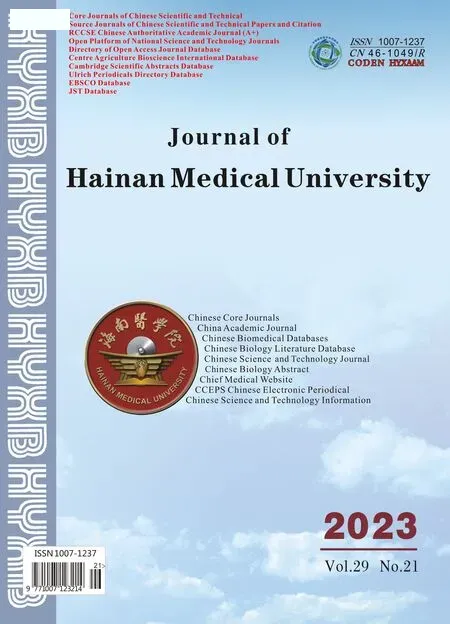 Journal of Hainan Medical College2023年21期
Journal of Hainan Medical College2023年21期
- Journal of Hainan Medical College的其它文章
- Assessment of gastric cancer prognosis, immune infiltration based on cuproptosis-related LncRNAs and prediction of traditional Chinese medicine
- Mechanism of AiTongXiao granule in the treatment of hepatocellular carcinoma based on network pharmacology and rat transplanted liver cancer model
- The effect and mechanism of stilbene glycosides on improving neuronal injury in Alzheimer's disease rats by regulating ASK/MKK7/JNK pathway
- Preparation of adhesive resveratrol micelles and determination of drug content
- BMSCs transplantation inhibits neuronal apoptosis after subarachnoid hemorrhage in rats through activation of AMPK/mTOR signaling pathway-mediated autophagy
- Research progress of necroptosis and ferroptosis in knee osteoarthritis
